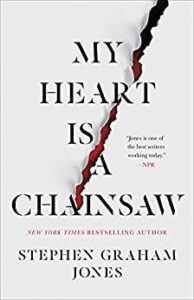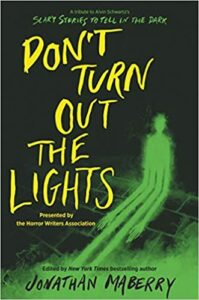My Heart is a Chainsaw by Stephen Graham Jones
Gallery/Saga Press, 2021
ISBN-13 : 978-1982137632
Available: Hardcover, Kindle edition, audiobook ( Bookshop.org | Amazon.com )
Jade Daniels is part Blackfeet, but she’s 100% a fan of slasher movies. Living with her divorced, alcoholic father and barely scraping through high school while working as a janitor, where her drug-dealing boss is sexually harassing her, she spends most of her time watching slasher flicks, from the obscure to the popular. Without anyone to talk to about her love of these movies, she puts her energy and knowledge about them, and especially about final girls, in her extra-credit history papers. She is certain there’s a slasher ready to start on her own community, Proofrock, located in rural Idaho, if only she can identify the final girl and educate her. There are plenty of places that would make perfect locations and reasons for revenge, like Camp Blood, an abandoned summer camp on the lake that was closed after mysterious deaths, and Terra Nova, the new, exclusive development that’s being built on the opposite side of the lake on land that until recently was part of a national forest. There are even spooky urban legends.
Then Jade meets Letha Mondragon, daughter of the developer of Terra Nova. She thinks she’s met her final girl, and that finally the bloodshed is about to start. Jade just has to figure out where and why, and educate Letha on the ins and outs of surviving to be the final girl. Jade is about to discover, though, that life doesn’t always fit a pre-defined narrative.
My Heart is a Chainsaw is a love letter to the slasher genre and a validation for those who grew up loving it. If you aren’t a fan of slasher films, the references to even obscure slasher films will go over your head. The structure of the book means the narrative is frequently interrupted by Jade’s extra-credit papers on slasher films, which will help fill in the blanks for those who aren’t familiar with the genre, but while these build background knowledge, they do slow the narrative down. The characters aren’t especially likable and it’s sometimes even confusing to tell them apart. Jones doesn’t even name some of them, although when he does choose to develop a character he does it thoroughly.
As the reader gets further into the book the pace picks up and the body count rises. There are absolutely gruesome moments as well as plenty of gore. I do not have a strong stomach for these, so it’s a testament to Jones’ writing that I read this from beginning to end almost nonstop. Readers who love slasher films and have a high tolerance for violence and gore will find a lot to like in this bloody valentine.
Contains: violence, blood, gore, mass murder, sexual harassment, implied child sexual abuse, attempted suicide
Reviewed by Kirsten Kowalewski







Follow Us!